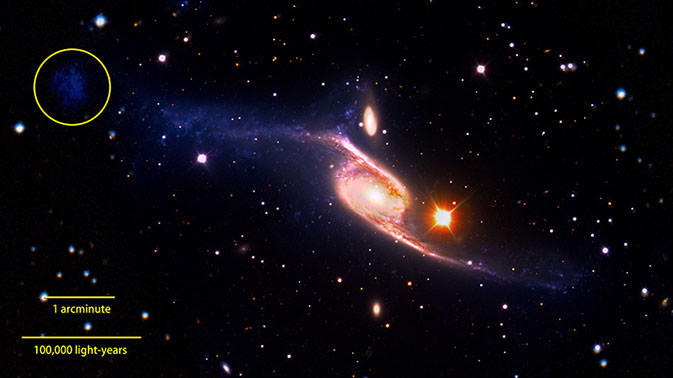Astronomers have long known that a spectacular barred spiral galaxy named NGC 6872 is a behemoth, but by compiling data from several space- and ground-based observatories and running a few computer simulations, they have now determined this is the largest spiral galaxy we know of.
Measuring tip-to-tip across its two outsized spiral arms, NGC 6872 spans more than 522,000 light-years, making it more than five times the size of our Milky Way galaxy.
“Without GALEX’s ability to detect the ultraviolet light of the youngest, hottest stars, we would never have recognized the full extent of this intriguing system,” said lead scientist Rafael Eufrasio, from the Goddard Space Flight Center the Catholic University of America in Washington. He presented the findings Thursday at the American Astronomical Society meeting in Long Beach, California.
But this galaxy didn’t get so gargantuan all on its own. Astronomers think large galaxies, including our own, grew through mergers and acquisitions — assembling over billions of years by absorbing numerous smaller systems.
The galaxy’s unusual size and appearance stem from its interaction with a much smaller disk galaxy named IC 4970, which has only about one-fifth the mass of NGC 6872. The odd couple is located 212 million light-years from Earth in the southern constellation Pavo.
Intriguingly, the gravitational interaction of NGC 6872 and IC 4970 may have done the opposite, spawning what may develop into a new small galaxy.
“The northeastern arm of NGC 6872 is the most disturbed and is rippling with star formation, but at its far end, visible only in the ultraviolet, is an object that appears to be a tidal dwarf galaxy similar to those seen in other interacting systems,” said team member Duilia de Mello, a professor of astronomy at Catholic University.
The researchers used archived data from the Galaxy Evolution Explorer (GALEX) mission, and studied the galaxy across the spectrum using data from the European Southern Observatory’s Very Large Telescope, the Two Micron All Sky Survey, and NASA’s Spitzer Space Telescope.
Source: NASA


How does its size compare with Malin 1?
Better still, versus IC_1101
“Malin 1 is a giant low surface brightness (LSB) disk galaxy which is 650,000 light years across, five and a half times the diameter of our Milky Way”. The source is Wikipedia. Malin 1 is bigger by 128.000 light years.
NGC 6872 spans more than 522,000 light-years, means 4.936381 x 10^23 cm. But Avo. No. / root of 3/2 = 4.917054 x 10^23 cm, if we consider Avo. No. as a distance. I calculate the distances of many stars, galaxies, planets by using my magic unit and got almost correct results. Regarding the distance of the universe written in my book “Complete Unified Theory” ( page-424, 1998).
I regard this ‘record’ a little forced: it only results from the stretcjing out into the very elongated shape by tidal interaction. A more relevant measure would be the mass – prbably more related to the size of the compact üart of the galaxy and the density of that.
If I remember correctly, also Andromeda galaxy has been found to possess a low density halo of order 500 000 ly
Funny, I was eager to read more about this newly found tidal dwarf galaxy only to find the linked research paper (by a pair of different authors) is six years old and doesn’t mention GALEX observations of NGC 6872 or the TDG. SIMBAD and NED don’t seem to contain any relevant papers either. What gives?
Apparently, the info in this article was presented at the 2013 AAS meeting as “When the UV Unveils the Largest Spiral” by Eufrasio et al: http://adsabs.harvard.edu/abs/2013AAS…22114710E